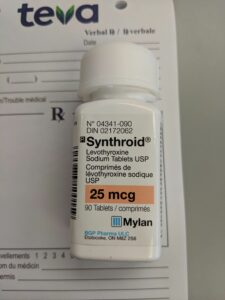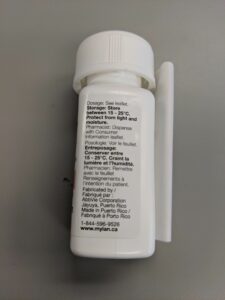Is Synthroid in Canada the same as in the U.S.?
[Update June 2019: Some comments on this blog post may lead readers to believe the Canadian version of Synthroid “works better” than the ones sold in the U.S. or India, and vice versa. Different people respond to medications differently, hence why it’s difficult to affirm one “works” better than the other.
On the subject at hand, we believe that the Synthroid sold in the U.S. and that sold in Canada are the same medication, based on the below pill bottles sold in Canada and our contact with Abbvie concerning Synthroid sold in the U.S.
Synthroid marketed in the United States is manufactured in the United States, Puerto Rico, and Ireland (Data on file, AbbVie). AbbVie sources ingredients for Synthroid marketed in the United States from the United States, Puerto Rico, France, Italy, Japan, Mexico, and Germany.
This information is subject to change. If this information is needed in the future, please contact AbbVie Global Medical Information for updated information.
Thank you for continuing the conversation.]
Synthroid is the brand name for a medication called levothyroxine, which is manufactured by drug company Abbvie in the U.S. and Mylan in Canada. It treats hypothyroidism, as well as enlarged thyroid gland and thyroid cancer. Synthroid sells for about $100 for a three-month supply in the U.S. compared to $32 in Canada. Over the course of a year, since this is a maintenance medication, the annual costs are $400 vs. $128. You compare Synthroid brand prices here. This is a very popular drug: about 23 million prescriptions are written monthly for Synthroid. For Americans who do not have insurance or their insurance doesn’t cover Synthroid, buying it from Canada means real savings. But will they be getting the exact same drug?
After all, there are generic versions of levothyroxine sold in the U.S. that cost even less than Synthroid in Canada: $10 at Walmart for a three-month supply. For most medications (but there are exceptions) your best bet is the lower cost U.S. generic compared to a higher cost brand drug internationally. In the U.S., the FDA affirms that approved generics are bioequivalent to the brands, meaning the active ingredient has the same rate and extent of absorption in the bloodstream (for all intents and purposes they are the same). But for some medications, especially those with a narrow therapeutic index, your provider may not want you to take a generic. Medications with a narrow therapeutic index have a narrow range between the drug’s risks and its benefits and small differences in dose or blood concentration may matter, meaning it’s more critical that the amount of pharmaceutical ingredient is precise and delivered correctly through the bloodstream. But what about brand products of the same medication made in different countries? (more…)
Tagged with: AbbVie, levothyroxine, mylan, Synthroid




